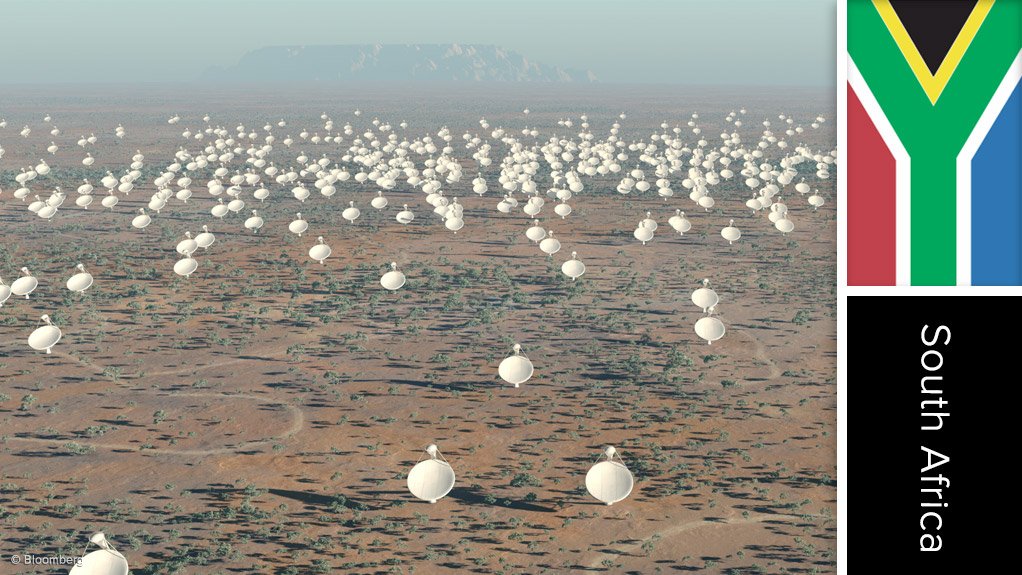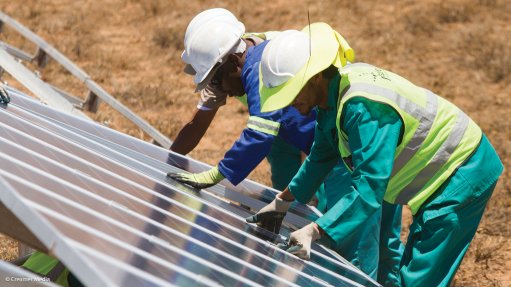Square Kilometre Array project, Africa and Australia
Name of the Project
Square Kilometre Array (SKA) project.
Location
Africa and Australia.
Project Owner/s
The international SKA project is run by the UK-based SKA Organisation, which currently comprises Australia, Canada, China, Germany, Italy, the Netherlands, New Zealand, South Africa, Sweden and the UK. India is an associate member and is expected to become a full member shortly.
The SKA Organisation formalises relationships between the international partners and centralises the leadership project.
The project in South Africa is the responsibility of a separate, local organisation, SKA SA.
Project Description
The SKA will provide one-million square metres of collecting area, which demands a revolutionary break from traditional radio-telescope design.
The project will use three types of antennas (radio-wave receptors) – dishes, midfrequency aperture arrays and low-frequency aperture arrays – to provide continuous frequency coverage from 70 MHz to 10 GHz. Combining the signals from the antennas will create a telescope with a collecting area equivalent to a dish with an area of about 1 km2.
The first phase of the SKA, known as SKA1, will result in the creation of two complementary instruments, one each in South Africa and Australia.
The South African instrument, known as SKA1–Mid, will comprise about 200 dishes and operate in the 350 MHz to 14 GHz frequency range. The Australian instrument, known as SKA1–Low, will comprise more than 100 000 (perhaps as many as 130 000) dipole antennas and will operate in the 50 MHz to 350 MHz frequency range.
SKA1–Mid will include the 64 dishes of the South African precursor to the SKA, the MeerKAT radio telescope array, being built in the Karoo region. Australia’s precursor, the Australian SKA Pathfinder (better known as Askap and already in operation) will serve as surveying instrument for the SKA.
The central regions, in Australia and in South Africa, will contain cores, each 5 km in diameter – one for each antenna type. Fifty per cent of the collecting area will be within the central cores. The aperture array antennas will extend to about 200 km from the core regions. In Africa, the dishes will be positioned at distant stations that are 3 000 km from the core regions.
The construction of the SKA will be phased.
Phase 1 (SKA1) will comprise about 10% of the array and will include dishes and low-frequency aperture arrays.
The Australian SKA Pathfinder and South Africa’s Meerkat precursor dishes will be incorporated in the SKA1. The Murchison Widefield Array, located at the Australia site, is another precursor telescope to the SKA.
Phase 2 (SKA2) will extend the array with midfrequency aperture arrays and further dishes.
All the dishes for SKA2 will be located in Africa. All the low-frequency aperture arrays will be located in Australia and all the midfrequency aperture arrays will be built in Southern Africa.
The phased construction of the telescope will mean that the SKA can start operating before construction is completed.
Potential Job Creation
More than 1 000 engineers and scientists in 20 countries have been involved in designing the SKA over the past five years, with new research programmes and educational initiatives and collaborations being created in various countries to train the next generation of space scientists and engineers.
Capital Expenditure
SKA1 is expected to cost €650-million (about R8.9-billion).
Planned Start /End Date
Construction of the first phase of the SKA is expected to start in 2021.
Latest Developments
South Africa has signed the international treaty establishing the Square Kilometre Array Observatory (SKAO) – an intergovernmental organisation tasked with building and operating the world's most powerful radio astronomy telescope.
South Africa, Australia, China, Italy, the Netherlands, Portugal and the UK signed the treaty on March 12, concluding four years of negotiations by government representatives and international lawyers, and starting the legislative process in each of the seven countries.
India and Sweden, who also took part in the multilateral negotiations, have one year to sign the treaty. These nine countries will then form the founding members of the new intergovernmental organisation.
The treaty establishes the SKAO as only the second intergovernmental organisation dedicated to astronomy in the world, after the European Southern Observatory, and will ensure strong governance of the SKA project.
"South Africa's signature on the establishment of the SKAO as an intergovernmental legal entity to oversee the construction and operational phases of the SKA project is a crucial milestone and one which should be celebrated.
"What makes this particularly unique is . . . that, for the first time, Africa, Asia, Australasia and Europe have committed at intergovernmental level to collaborate on a large-scale science project as equal partners. This represents the start of a new era for global science governance," Science and Technology Minister Mmamoloko Kubayi-Ngubane has said.
The treaty has been named the Rome Convention in recognition of Italy's role in the negotiation process. It will come into force once it has been ratified by the legislatures of five signatory countries, including all three SKA hosts – South Africa, Australia and the UK.
Construction of the first phase of the SKA is expected to start in 2021. Three prototype dishes are being built as part of the SKA critical design review – the final stage of design work before construction begins.
One of these prototypes is being assembled at South Africa's SKA site in the Northern Cape, which is also home to the 64-dish MeerKAT telescope.
Key Contracts and Suppliers
South Africa: Neotel/Broadband Infraco joint venture, or JV (bandwidth network); Eskom (electricity); Telkom (telecommunications); and Nokia Siemens Networks, Intel, Seacom, Dimension Data, Microsoft and IBM (connectivity support).
On Budget and on Time?
The project is reportedly on course.
Contact Details for Project Information
SKA South Africa head communication and stakeholder relations Lorenzo Raynard, cell +27 71 454 0658 or email lraynard@ska.ac.za.
Comments
Press Office
Announcements
What's On
Subscribe to improve your user experience...
Option 1 (equivalent of R125 a month):
Receive a weekly copy of Creamer Media's Engineering News & Mining Weekly magazine
(print copy for those in South Africa and e-magazine for those outside of South Africa)
Receive daily email newsletters
Access to full search results
Access archive of magazine back copies
Access to Projects in Progress
Access to ONE Research Report of your choice in PDF format
Option 2 (equivalent of R375 a month):
All benefits from Option 1
PLUS
Access to Creamer Media's Research Channel Africa for ALL Research Reports, in PDF format, on various industrial and mining sectors
including Electricity; Water; Energy Transition; Hydrogen; Roads, Rail and Ports; Coal; Gold; Platinum; Battery Metals; etc.
Already a subscriber?
Forgotten your password?
Receive weekly copy of Creamer Media's Engineering News & Mining Weekly magazine (print copy for those in South Africa and e-magazine for those outside of South Africa)
➕
Recieve daily email newsletters
➕
Access to full search results
➕
Access archive of magazine back copies
➕
Access to Projects in Progress
➕
Access to ONE Research Report of your choice in PDF format
RESEARCH CHANNEL AFRICA
R4500 (equivalent of R375 a month)
SUBSCRIBEAll benefits from Option 1
➕
Access to Creamer Media's Research Channel Africa for ALL Research Reports on various industrial and mining sectors, in PDF format, including on:
Electricity
➕
Water
➕
Energy Transition
➕
Hydrogen
➕
Roads, Rail and Ports
➕
Coal
➕
Gold
➕
Platinum
➕
Battery Metals
➕
etc.
Receive all benefits from Option 1 or Option 2 delivered to numerous people at your company
➕
Multiple User names and Passwords for simultaneous log-ins
➕
Intranet integration access to all in your organisation





















